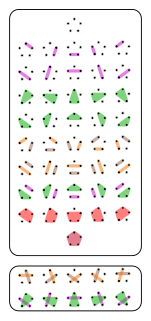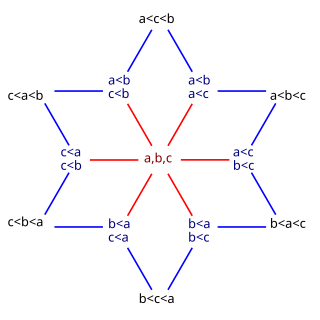In mathematics, the classic Möbius inversion formula is a relation between pairs of arithmetic functions, each defined from the other by sums over divisors. It was introduced into number theory in 1832 by August Ferdinand Möbius.

In number theory and combinatorics, a partition of a positive integer n, also called an integer partition, is a way of writing n as a sum of positive integers. Two sums that differ only in the order of their summands are considered the same partition. For example, 4 can be partitioned in five distinct ways:
In combinatorial mathematics, the theory of combinatorial species is an abstract, systematic method for deriving the generating functions of discrete structures, which allows one to not merely count these structures but give bijective proofs involving them. Examples of combinatorial species are graphs, permutations, trees, and so on; each of these has an associated generating function which counts how many structures there are of a certain size. One goal of species theory is to be able to analyse complicated structures by describing them in terms of transformations and combinations of simpler structures. These operations correspond to equivalent manipulations of generating functions, so producing such functions for complicated structures is much easier than with other methods. The theory was introduced, carefully elaborated and applied by the Canadian group of people around André Joyal.
In mathematics, a generating function is a way of encoding an infinite sequence of numbers (an) by treating them as the coefficients of a formal power series. This series is called the generating function of the sequence. Unlike an ordinary series, the formal power series is not required to converge: in fact, the generating function is not actually regarded as a function, and the "variable" remains an indeterminate. Generating functions were first introduced by Abraham de Moivre in 1730, in order to solve the general linear recurrence problem. One can generalize to formal power series in more than one indeterminate, to encode information about infinite multi-dimensional arrays of numbers.
In combinatorial mathematics, the Bell numbers count the possible partitions of a set. These numbers have been studied by mathematicians since the 19th century, and their roots go back to medieval Japan. In an example of Stigler's law of eponymy, they are named after Eric Temple Bell, who wrote about them in the 1930s.

In combinatorial mathematics, the Catalan numbers are a sequence of natural numbers that occur in various counting problems, often involving recursively defined objects. They are named after the French-Belgian mathematician Eugène Charles Catalan (1814–1894).
In mathematics, a Dirichlet series is any series of the form
In mathematics, the term combinatorial proof is often used to mean either of two types of mathematical proof:
The Wedderburn–Etherington numbers are an integer sequence named for Ivor Malcolm Haddon Etherington and Joseph Wedderburn that can be used to count certain kinds of binary trees. The first few numbers in the sequence are
In combinatorics, the symbolic method is a technique for counting combinatorial objects. It uses the internal structure of the objects to derive formulas for their generating functions. The method is mostly associated with Philippe Flajolet and is detailed in Part A of his book with Robert Sedgewick, Analytic Combinatorics, while the rest of the book explains how to use complex analysis in order to get asymptotic and probabilistic results on the corresponding generating functions.

In mathematics and especially in combinatorics, a plane partition is a two-dimensional array of nonnegative integers that is nonincreasing in both indices. This means that
The Pólya enumeration theorem, also known as the Redfield–Pólya theorem and Pólya counting, is a theorem in combinatorics that both follows from and ultimately generalizes Burnside's lemma on the number of orbits of a group action on a set. The theorem was first published by J. Howard Redfield in 1927. In 1937 it was independently rediscovered by George Pólya, who then greatly popularized the result by applying it to many counting problems, in particular to the enumeration of chemical compounds.

In number theory and enumerative combinatorics, the ordered Bell numbers or Fubini numbers count the number of weak orderings on a set of n elements. Starting from n = 0, these numbers are
The use of exponential generating functions (EGFs) to study the properties of Stirling numbers is a classical exercise in combinatorial mathematics and possibly the canonical example of how symbolic combinatorics is used. It also illustrates the parallels in the construction of these two types of numbers, lending support to the binomial-style notation that is used for them.

In combinatorics, an area of mathematics, graph enumeration describes a class of combinatorial enumeration problems in which one must count undirected or directed graphs of certain types, typically as a function of the number of vertices of the graph. These problems may be solved either exactly or asymptotically. The pioneers in this area of mathematics were George Pólya, Arthur Cayley and J. Howard Redfield.

In combinatorics, the Schröder–Hipparchus numbers form an integer sequence that can be used to count the number of plane trees with a given set of leaves, the number of ways of inserting parentheses into a sequence, and the number of ways of dissecting a convex polygon into smaller polygons by inserting diagonals. These numbers begin
In combinatorial mathematics, the labelled enumeration theorem is the counterpart of the Pólya enumeration theorem for the labelled case, where we have a set of labelled objects given by an exponential generating function (EGF) g(z) which are being distributed into n slots and a permutation group G which permutes the slots, thus creating equivalence classes of configurations. There is a special re-labelling operation that re-labels the objects in the slots, assigning labels from 1 to k, where k is the total number of nodes, i.e. the sum of the number of nodes of the individual objects. The EGF of the number of different configurations under this re-labelling process is given by

In mathematics, the telephone numbers or the involution numbers form a sequence of integers that count the ways n telephone lines can be connected to each other, where each line can be connected to at most one other line. These numbers also describe the number of matchings of a complete graph on n vertices, the number of permutations on n elements that are involutions, the sum of absolute values of coefficients of the Hermite polynomials, the number of standard Young tableaux with n cells, and the sum of the degrees of the irreducible representations of the symmetric group. Involution numbers were first studied in 1800 by Heinrich August Rothe, who gave a recurrence equation by which they may be calculated, giving the values
A Boltzmann sampler is an algorithm intended for random sampling of combinatorial structures. If the object size is viewed as its energy, and the argument of the corresponding generating function is interpreted in terms of the temperature of the physical system, then a Boltzmann sampler returns an object from a classical Boltzmann distribution.
In mathematics, the plethystic exponential is a certain operator defined on (formal) power series which, like the usual exponential function, translates addition into multiplication. This exponential operator appears naturally in the theory of symmetric functions, as a concise relation between the generating series for elementary, complete and power sums homogeneous symmetric polynomials in many variables. Its name comes from the operation called plethysm, defined in the context of so-called lambda rings.



























